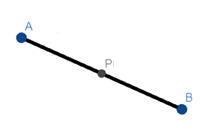
Find the locus of a point so that its distance from the point (3,0) is three times its distance from (0,2).
Answer
604.2k+ views
Hint: Take the point P as (h, k) use the distance formula which is, $\sqrt{{{\left( {{x}_{2}}-{{x}_{1}} \right)}^{2}}+{{\left( {{y}_{2}}-{{y}_{1}} \right)}^{2}}}$ and take the two points as A and B. Then apply the condition that is PA=3PB as the point P is three times its distance from the other point and find the result.
Complete step-by-step answer:
Locus is a set of points making a curve or surface that satisfy conditions like equidistance. We have been given points A(3,0) and B(0,2). Let us assume a point P(h,k) which satisfies the given condition of being as three times distant from B(0,2) as distant from A(3,0).

Mathematically,
$PA=3PB..............(i)$
Using the distance formula for points,
$d=\sqrt{{{\left( {{x}_{2}}-{{x}_{1}} \right)}^{2}}+{{\left( {{y}_{2}}-{{y}_{1}} \right)}^{2}}}...........(ii)$
Substituting the values of the coordinates from A(3,0) and P(h,k) in equation (ii), we have
$\begin{align}
& PA=\sqrt{{{\left( h-3 \right)}^{2}}+{{\left( k-0 \right)}^{2}}} \\
& \Rightarrow PA=\sqrt{{{\left( h-3 \right)}^{2}}+{{k}^{2}}}.........(iii) \\
\end{align}$
Similarly, substituting the values of the coordinates from B(0, 2) and P(h, k) in equation (ii), we have
$\begin{align}
& PB=\sqrt{{{\left( h-0 \right)}^{2}}+{{\left( k-2 \right)}^{2}}} \\
& \Rightarrow PB=\sqrt{{{h}^{2}}+{{\left( k-2 \right)}^{2}}}.........(iv) \\
\end{align}$
Substituting the values of PA and PB in equation (i), we get
$\sqrt{{{\left( h-3 \right)}^{2}}+{{k}^{2}}}=3\sqrt{{{h}^{2}}+{{\left( k-2 \right)}^{2}}}$
On squaring both sides, we get
$\begin{align}
& {{\left( h-3 \right)}^{2}}+{{k}^{2}}={{\left( 3 \right)}^{2}}\left[ {{h}^{2}}+{{\left( k-2 \right)}^{2}} \right] \\
& \Rightarrow {{\left( h-3 \right)}^{2}}+{{k}^{2}}=9\left[ {{h}^{2}}+{{\left( k-2 \right)}^{2}} \right].............(v) \\
\end{align}$
Now we will use the identity ${{\left( a-b \right)}^{2}}={{a}^{2}}-2ab+{{b}^{2}}$ we can write equation (v) as,
$\begin{align}
& {{h}^{2}}-6h+9+{{k}^{2}}=9\left[ {{h}^{2}}+{{k}^{2}}-4k+4 \right] \\
& \Rightarrow {{h}^{2}}-6h+9+{{k}^{2}}=9{{h}^{2}}+9{{k}^{2}}-36k+36 \\
& \Rightarrow 9{{h}^{2}}+9{{k}^{2}}-36k+36-{{h}^{2}}+6h-9-{{k}^{2}}=0 \\
& \Rightarrow 8{{h}^{2}}+8{{k}^{2}}+6h-36k+27=0..........(vi) \\
\end{align}$
The equation (vi) satisfies a single locus point P for the given condition. Now for generalisation for all the points satisfying the given condition we can replace (h, k) with general variables (x, y). Therefore the required equation is
$8{{x}^{2}}+8{{y}^{2}}+6x-36y+27=0$
The required locus for the given condition is $8{{x}^{2}}+8{{y}^{2}}+6x-36y+27=0$.
Note: The chances of mistakes are if while using the distance formula you are only calculating the distance of AB. We need to find the locus of a point that satisfies the given condition for the points (3,0) and (2,0).
Complete step-by-step answer:
Locus is a set of points making a curve or surface that satisfy conditions like equidistance. We have been given points A(3,0) and B(0,2). Let us assume a point P(h,k) which satisfies the given condition of being as three times distant from B(0,2) as distant from A(3,0).

Mathematically,
$PA=3PB..............(i)$
Using the distance formula for points,
$d=\sqrt{{{\left( {{x}_{2}}-{{x}_{1}} \right)}^{2}}+{{\left( {{y}_{2}}-{{y}_{1}} \right)}^{2}}}...........(ii)$
Substituting the values of the coordinates from A(3,0) and P(h,k) in equation (ii), we have
$\begin{align}
& PA=\sqrt{{{\left( h-3 \right)}^{2}}+{{\left( k-0 \right)}^{2}}} \\
& \Rightarrow PA=\sqrt{{{\left( h-3 \right)}^{2}}+{{k}^{2}}}.........(iii) \\
\end{align}$
Similarly, substituting the values of the coordinates from B(0, 2) and P(h, k) in equation (ii), we have
$\begin{align}
& PB=\sqrt{{{\left( h-0 \right)}^{2}}+{{\left( k-2 \right)}^{2}}} \\
& \Rightarrow PB=\sqrt{{{h}^{2}}+{{\left( k-2 \right)}^{2}}}.........(iv) \\
\end{align}$
Substituting the values of PA and PB in equation (i), we get
$\sqrt{{{\left( h-3 \right)}^{2}}+{{k}^{2}}}=3\sqrt{{{h}^{2}}+{{\left( k-2 \right)}^{2}}}$
On squaring both sides, we get
$\begin{align}
& {{\left( h-3 \right)}^{2}}+{{k}^{2}}={{\left( 3 \right)}^{2}}\left[ {{h}^{2}}+{{\left( k-2 \right)}^{2}} \right] \\
& \Rightarrow {{\left( h-3 \right)}^{2}}+{{k}^{2}}=9\left[ {{h}^{2}}+{{\left( k-2 \right)}^{2}} \right].............(v) \\
\end{align}$
Now we will use the identity ${{\left( a-b \right)}^{2}}={{a}^{2}}-2ab+{{b}^{2}}$ we can write equation (v) as,
$\begin{align}
& {{h}^{2}}-6h+9+{{k}^{2}}=9\left[ {{h}^{2}}+{{k}^{2}}-4k+4 \right] \\
& \Rightarrow {{h}^{2}}-6h+9+{{k}^{2}}=9{{h}^{2}}+9{{k}^{2}}-36k+36 \\
& \Rightarrow 9{{h}^{2}}+9{{k}^{2}}-36k+36-{{h}^{2}}+6h-9-{{k}^{2}}=0 \\
& \Rightarrow 8{{h}^{2}}+8{{k}^{2}}+6h-36k+27=0..........(vi) \\
\end{align}$
The equation (vi) satisfies a single locus point P for the given condition. Now for generalisation for all the points satisfying the given condition we can replace (h, k) with general variables (x, y). Therefore the required equation is
$8{{x}^{2}}+8{{y}^{2}}+6x-36y+27=0$
The required locus for the given condition is $8{{x}^{2}}+8{{y}^{2}}+6x-36y+27=0$.
Note: The chances of mistakes are if while using the distance formula you are only calculating the distance of AB. We need to find the locus of a point that satisfies the given condition for the points (3,0) and (2,0).
Recently Updated Pages
Master Class 11 Business Studies: Engaging Questions & Answers for Success

Master Class 11 Computer Science: Engaging Questions & Answers for Success

Master Class 11 Maths: Engaging Questions & Answers for Success

Master Class 11 Chemistry: Engaging Questions & Answers for Success

Master Class 11 Economics: Engaging Questions & Answers for Success

Master Class 11 Accountancy: Engaging Questions & Answers for Success

Trending doubts
What is meant by exothermic and endothermic reactions class 11 chemistry CBSE

10 examples of friction in our daily life

One Metric ton is equal to kg A 10000 B 1000 C 100 class 11 physics CBSE

1 Quintal is equal to a 110 kg b 10 kg c 100kg d 1000 class 11 physics CBSE

Difference Between Prokaryotic Cells and Eukaryotic Cells

What are Quantum numbers Explain the quantum number class 11 chemistry CBSE




